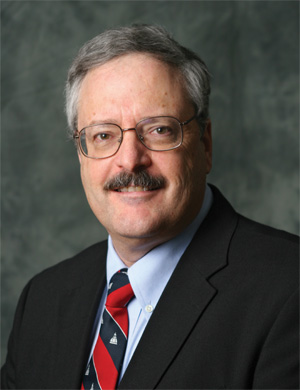Meet Jerry Hart
Gerald “Jerry” W. Hart is an American Society for Biochemistry and Molecular Biology journal regular, having served as an associate editor for Molecular & Cellular Proteomics since 2008, and last year he agreed to put on yet another hat for the society and for science by joining the ranks of the Journal of Biological Chemistry associate editors. Hart, director of the biological chemistry department at the Johns Hopkins University School of Medicine, has published 54 papers in the JBC. Here he offers some insights on his relationship with ASBMB journals and his work at his home institution.

Would you briefly explain what your research group is studying?
In the early 1980s, we discovered that the textbooks were all wrong about protein glycosylation by finding that many proteins within the nucleus and cytoplasm are indeed glycosylated. In the past 27 years, we have found that this cycling sugar modification of proteins – called O-linked N-acetylglucosamine, or O-GlcNAc – is nearly as common as protein phosphorylation and often competes with it at the same or proximal sites on proteins to regulate nearly every cellular process in response to nutrients and stress. O-GlcNAc not only plays a key role in signaling, in transcription and in cytoskeletal functions, but it also underlies glucose toxicity in diabetes, is important in neurodegenerative diseases and is important in cancer etiology. Our research is focused on elucidating the molecular functions of this ubiquitous and essential post-translational modification.
Tell us about your academic background and research training.
I earned my Ph.D. in developmental biology from Kansas State University, working with professor Gary W. Conrad. Gary was a postdoctoral fellow with Albert Dorfman, an early pioneer in the field of proteoglycans. Gary was a fantastic mentor who not only demanded rigor in science but also inspired everyone with his enthusiasm and keen intellect. Gary is one of the best teachers I’ve ever known.
What was your doctoral research?
I studied the molecular basis for the development of corneal transparency. In particular, I focused on the roles of sulfated proteoglycans, such as keratin sulfate type I, and on chondroitin sulfates in controlling collagen organization and optical properties of the tissue.
And with whom did you train as a postdoc, and what was your work there?
From June 1977 to July 1979, I was a Jane Coffin Childs postdoctoral fellow in the laboratory of professor William J. Lennarz in the physiological chemistry department (now biological chemistry) at Johns Hopkins University School of Medicine. There, I showed that keratin sulfate type I was made via the N-linked glycosylation pathway via oligosaccharyl transferase, and I experimentally established that the sequon Asn-X-Ser(Thr) is the minimal recognition sequence for N-linked glycosylation. I joined the faculty as an assistant professor in the same department in July 1979.
Did anything occur, in a milestone sort of way, that made you choose science as a career?
I basically was born wanting to be a scientist. Since my earliest days, I knew that I wanted to be a scientist. My mother, in particular, encouraged this by allowing me to have a “laboratory” in my bedroom even when I was still fairly young.
During grad school and/or postdoc, did something especially impress you to choose the path you’ve blazed in research?
Yes, my work on proteoglycans introduced me to the wonderful complexity and biological importance of glycans. Across the hall at KSU, Dr. Clayton Buck’s laboratory was doing pioneering work on the roles of glycans in cancer. In thinking about what molecules on the surfaces of cells had both the plasticity and molecular complexity to explain developmental programs, I knew it had to be the glycans. Growing up in Kansas, I had never even heard of Johns Hopkins. Dr. Buck showed me a review article in Science written by Bill Lennarz on N-linked glycans and suggested that I consider his laboratory. It was pure luck that I went there. Even knowing what I know today about the field of glycobiology, I would still pick the same laboratory. It was a great experience.
What does MCP offer that wasn’t available before its creation?
MCP is the premier journal in the field of proteomics for very good reasons. Not only does MCP require proteomics data to be of good quality and to be held to a high standard of rigor, but MCP also requires authors to demonstrate clearly the biological or biochemical significance of their data. The proteomic data must advance the field in a significant way and not just serve as an archive of large data sets. This focus on rigor and on the biological significance of the study sets MCP apart and above other proteomic journals.
You have published 54 articles in the JBC. What’s the draw for you?
As a graduate student, a postdoctoral fellow and a faculty member at Johns Hopkins, JBC was the place to publish. First, unlike the news magazines like Science or Nature, you always get your paper reviewed by scientific peers who are qualified to evaluate the science. Instead of peer review, for the most part, these other magazines hire nonscientists as gateway keepers who decide if a paper is trendy or not before it is peer-reviewed. In addition, JBC was founded by the chair of pharmacology at Johns Hopkins, John Jacob Abel, in 1905. Professor Abel hired our first department chair to found our department in 1908. Our department has always had strong ties to JBC and to ASBMB. Besides, JBC is clearly the best biochemistry journal there is. Why would you want to publish anywhere else?
So now that you’re an associate editor for both MCP and the JBC, how do you manage to juggle your responsibilities?
I have been doing both now for over six months, and it is not a problem. I have a lot of experience as an editor. In 1989, I founded the journal Glycobiology, now the leading specialty journal in this field, and I ran the journal for 12 years. During that same time, I also served on the editorial board of JBC for about 16 years. The BenchPress manuscript-tracking system really makes the associate editor job much easier.
What do you do outside of the lab? Hobbies?
I am an avid swimmer. Beyond that, I can’t think of anything I’d rather do than research. It is my hobby and my job.
For scientists in training, do you have any words of wisdom or a favorite motto?
I tell my students: You should not go into science unless you love it. If you want to make money, go sell shoes or something. On the other hand, we scientists have the best job on the planet! We get paid to do what we love, to test our weird ideas, and we get to travel all over the world to discuss our ideas with other like-minded people. It doesn’t get any better than that!
Enjoy reading ASBMB Today?
Become a member to receive the print edition four times a year and the digital edition monthly.
Learn moreGet the latest from ASBMB Today
Enter your email address, and we’ll send you a weekly email with recent articles, interviews and more.
Latest in People
People highlights or most popular articles

Embrace your neurodivergence and flourish in college
This guide offers practical advice on setting yourself up for success — learn how to leverage campus resources, work with professors and embrace your strengths.

Survival tools for a neurodivergent brain in academia
Working in academia is hard, and being neurodivergent makes it harder. Here are a few tools that may help, from a Ph.D. student with ADHD.

Quieting the static: Building inclusive STEM classrooms
Christin Monroe, an assistant professor of chemistry at Landmark College, offers practical tips to help educators make their classrooms more accessible to neurodivergent scientists.

Hidden strengths of an autistic scientist
Navigating the world of scientific research as an autistic scientist comes with unique challenges —microaggressions, communication hurdles and the constant pressure to conform to social norms, postbaccalaureate student Taylor Stolberg writes.

Richard Silverman to speak at ASBMB 2025
Richard Silverman and Melissa Moore are the featured speakers at the ASBMB annual meeting to be held April 12-15 in Chicago.

Women’s History Month: Educating and inspiring generations
Through early classroom experiences, undergraduate education and advanced research training, women leaders are shaping a more inclusive and supportive scientific community.
